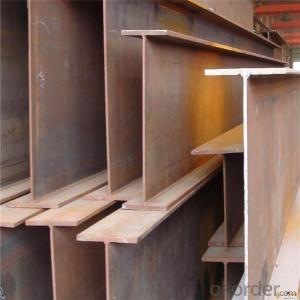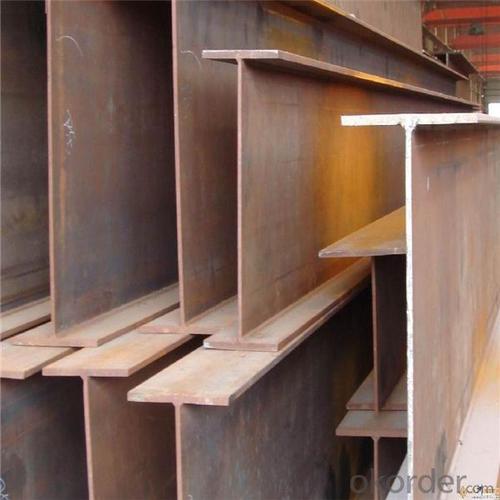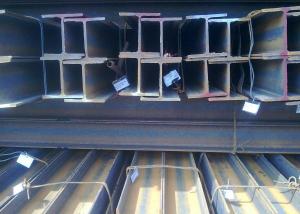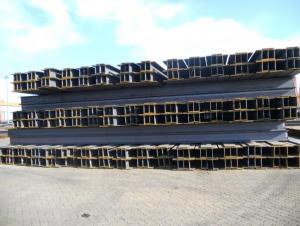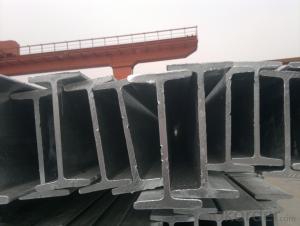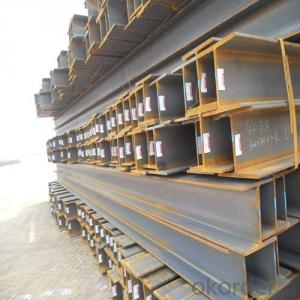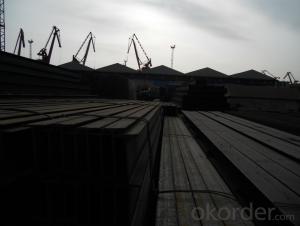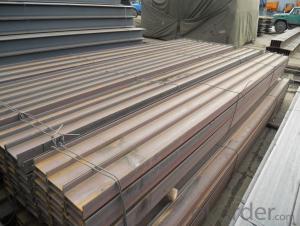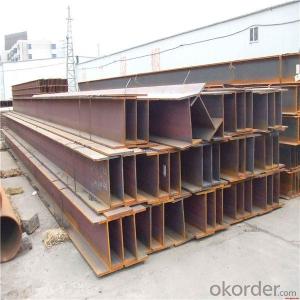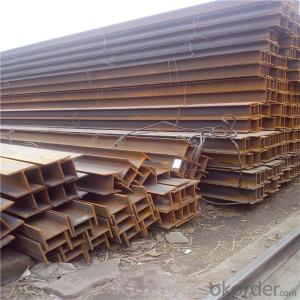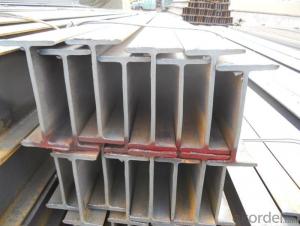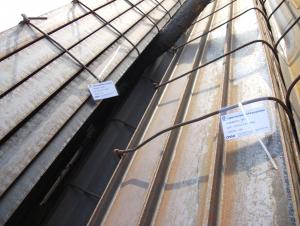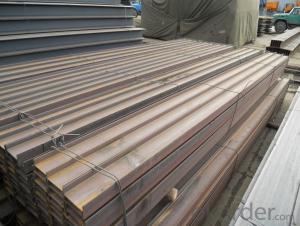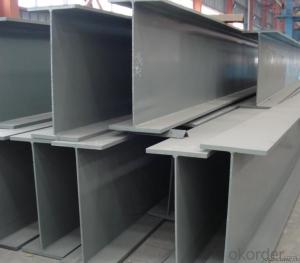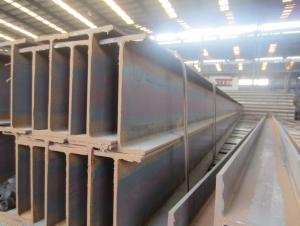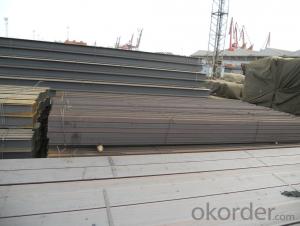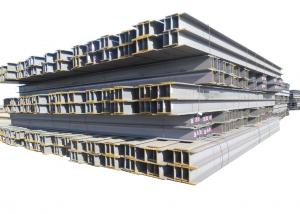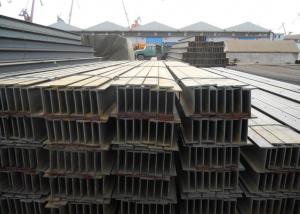GB Hot Rolled H Steel Beams Supplier from China
- Loading Port:
- Dalian
- Payment Terms:
- TT OR LC
- Min Order Qty:
- 125 m.t
- Supply Capability:
- 150000 m.t/month
OKorder Service Pledge
OKorder Financial Service
You Might Also Like
Specification
Quick Detail
Standard: | ASTM, GB, JIS | Grade: | Q235Q345ss400ss490 | Dimensions: | HM100*100*6*--8#428*407*20*35 |
Place of Origin: | Hebei, China (Mainland) | Brand Name: | JINXI | Type: | Alloy Structural Steel |
Application: | roof beam | Shape: | Beams | price: | competitive |
We can provide qualify goods,competitive price and speedy delivery.
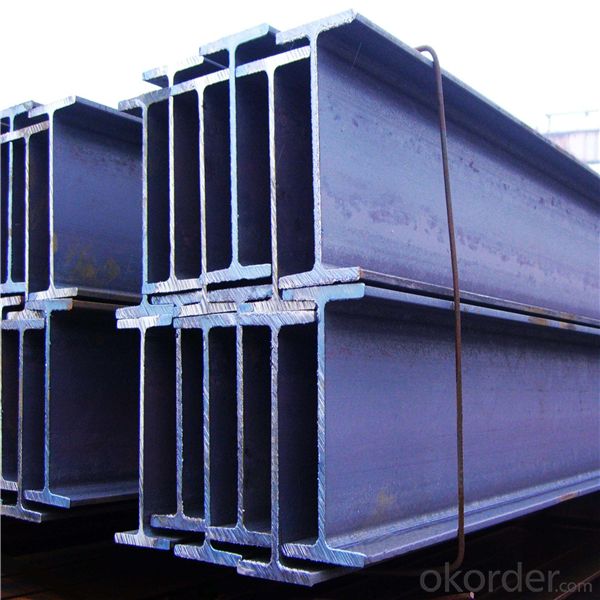
Products Description
Description | High Frenquency Thin-walled H Beam | |
Product Name | H Beam | |
Specification | Height:75-500mm Width:50-250mm | |
Standard | GB700-1998,GB/T1591-1994 | |
Material | Q235B,Q345B | |
Application | a. Bridge and post structures in industry and civil use of steel construction. | |
Certificates | ISO,SGS,BV,TUV,Lloyd | |
MOQ | 20 tons or according to customers’ requirement. | |
Port of Delivery | Tianjin Port of China | |
Remarks | We can provide qualify goods,competitive price and speedy delivery |
Packaging & Delivery
Packaging Details: | Packed with waterproof paper and steel banding. |
Delivery Detail: | 15-25 |
FAQ
1. How can I get some samples?
We are honored to offer you samples. New clients are expected to pay for the courier cost. The samples are free for you.
2 Do you have any certificates?
Our products passed inspection of SGS, FDA, and CE Quality is priority! Every worker keeps the QC from the very beginning to the very end, Quality control department especially responsible for quality checking in each process.
3 Can your factory print or emboss my logo on the goods?
Yes, we can print or emboss the logo on the goods or their packing box.
4 What information should I let you know if I want to get a quotation?
1) The specification of products (length x width x thickness);
2) The temper and alloy.
3) The final product you will use to be made
4 It will be better if you can show us the pictures or design sketch. Samples will be best for clarifying. If not, we will recommend relevant products with details for reference.We usually produce goods based on customers
Samples or based on customers’ picture, logo, sizes etc.
- Q: Are there any maintenance requirements for Steel H-Beams?
- Yes, steel H-beams require periodic maintenance to ensure their structural integrity and longevity. Maintenance activities may include inspecting for signs of corrosion, cracks, or deformation, and performing necessary repairs or replacements. Regular cleaning, such as removing dirt and debris, is also recommended to prevent the buildup of potentially damaging substances. Additionally, applying protective coatings or paints can help minimize the risk of corrosion and extend the lifespan of the beams. Overall, following manufacturer's guidelines and conducting routine maintenance is crucial for the optimal performance and durability of steel H-beams.
- Q: Can steel H-beams be used for supporting mining infrastructure?
- Yes, steel H-beams can be used for supporting mining infrastructure. H-beams are commonly used in construction and civil engineering projects due to their strength and versatility. They are designed to withstand heavy loads and provide structural support, making them suitable for use in mining infrastructure. The mining industry often requires robust support systems to ensure the stability and safety of underground tunnels, shafts, and other mining structures. Steel H-beams are ideal for this purpose as they offer high load-bearing capacity and resistance to bending, making them capable of withstanding the challenging conditions found in mining environments. Additionally, steel H-beams can be easily customized to meet specific project requirements. They can be cut to various lengths and welded together to form larger structural elements, allowing for the creation of complex support systems tailored to the unique needs of mining infrastructure. Furthermore, steel H-beams are durable and have a long lifespan, reducing the need for frequent maintenance or replacement. This is particularly important in the mining industry, where downtime and maintenance costs can significantly impact productivity and profitability. In summary, steel H-beams are a suitable choice for supporting mining infrastructure due to their strength, versatility, and durability. They provide the necessary support and stability required in mining environments, making them an excellent option for constructing and reinforcing underground mining structures.
- Q: What are the design considerations for steel H-beams in coastal areas?
- When designing steel H-beams for coastal areas, there are several important considerations that need to be taken into account. These considerations are primarily aimed at ensuring the durability and longevity of the H-beams in the corrosive and harsh coastal environment. 1. Corrosion resistance: Coastal areas are exposed to high levels of saltwater and humidity, which can accelerate the corrosion process. Therefore, it is crucial to select steel with excellent corrosion-resistant properties, such as stainless steel or galvanized steel. These materials have protective coatings that can withstand the corrosive nature of the coastal environment. 2. Coastal winds and storms: Coastal regions often experience strong winds and storms, which can exert significant forces on the H-beams. Designers should consider the wind load and ensure that the H-beams are adequately sized and reinforced to withstand these forces. Additionally, proper connections and fasteners should be used to ensure the structural integrity of the H-beams during extreme weather events. 3. Erosion and scour: Coastal areas are prone to erosion and scour, which can undermine the stability of the H-beams. To mitigate this risk, it is important to consider the soil conditions and design appropriate foundations for the H-beams. Measures such as using additional piling or protective barriers can also be implemented to prevent erosion and scour around the H-beams. 4. Maintenance and inspection: Due to the harsh coastal environment, regular maintenance and inspection are essential for steel H-beams. This includes periodic cleaning, repainting, and inspection for signs of corrosion or damage. Implementing a maintenance plan and ensuring that it is followed diligently will help extend the lifespan of the H-beams in coastal areas. 5. Environmental considerations: Coastal areas are often environmentally sensitive, with unique ecosystems and wildlife habitats. Designers should consider the potential impact of the H-beams on the environment and incorporate measures to minimize disruption. This can include using environmentally friendly coatings, avoiding sensitive areas, or implementing mitigation measures such as bird deterrents. In summary, when designing steel H-beams for coastal areas, considerations such as corrosion resistance, wind load, erosion and scour, maintenance and inspection, and environmental impact should all be taken into account. By addressing these factors, engineers can ensure the durability and resilience of the H-beams in the challenging coastal environment.
- Q: What are the different connection types for steel H-beams?
- The different connection types for steel H-beams include welded connections, bolted connections, and riveted connections.
- Q: Can steel H-beams be used in both residential and commercial construction?
- Certainly! Steel H-beams are applicable in both residential and commercial construction projects. These versatile and robust structural components are frequently employed to provide stability and support heavy loads in building structures. They are well-suited for a diverse range of applications, including the construction of residential houses, multi-story buildings, warehouses, industrial facilities, and commercial structures. Steel H-beams possess numerous benefits, such as a high strength-to-weight ratio, durability, and resistance to fire, corrosion, and pests. They can be effectively incorporated into various construction designs and endure substantial loads, making them a highly favored option for both residential and commercial construction projects.
- Q: What are the installation requirements for steel H-beams?
- The installation process for steel H-beams depends on several factors, including the application, load requirements, and structure design. However, there are general guidelines that can be followed. 1. Approval from a Structural Engineer: Before installing steel H-beams, it is crucial to seek the approval of a structural engineer who can evaluate the project's specific requirements and authorize the installation. 2. Preparation of the Site: The ground where the H-beams will be installed must be adequately prepared. This may involve clearing obstructions, leveling the ground, and establishing a stable foundation. 3. Lifting and Handling: Steel H-beams are heavy and require appropriate equipment like cranes or forklifts for lifting and positioning. Safety precautions must be followed during this process. 4. Alignment and Leveling: It is essential to ensure precise alignment and leveling of the H-beams according to the design specifications during installation. Laser levels or other alignment tools can assist in achieving this. 5. Connection Methods: H-beams are typically connected to other structural members using welding, bolting, or a combination of both. The specific method depends on design requirements and load considerations. 6. Welding: Certified welders should perform welding connections, adhering to industry standards and guidelines. Proper techniques, including pre-heating and post-welding inspections, ensure structural integrity. 7. Bolting: Connections made using bolts should utilize appropriate grade bolts and nuts. The engineer's torque specifications should be followed to achieve the required connection strength. 8. Bracing and Temporary Supports: Temporary supports or bracing may be necessary during installation to hold the H-beams in place until permanent connections are made. These supports must be designed and installed correctly for safety. 9. Inspection and Quality Control: Regular inspections should be conducted during installation to ensure compliance with all requirements and proper installation of the H-beams. Quality control measures must be implemented to identify any defects or deviations from design specifications. It is important to note that the installation requirements for steel H-beams can vary depending on the specific project and engineering requirements. Therefore, consulting a qualified engineer or contractor is recommended to receive detailed guidance and ensure a safe and efficient installation process.
- Q: Are steel H-beams suitable for residential extensions or additions?
- Yes, steel H-beams are suitable for residential extensions or additions. Steel H-beams offer several advantages that make them an excellent choice for supporting the structural integrity of a residential extension or addition. Firstly, steel H-beams have a high strength-to-weight ratio, meaning they can support heavy loads without being excessively bulky or heavy themselves. This allows for greater design flexibility and the ability to create open and spacious living areas without the need for numerous supporting columns or walls. Additionally, steel H-beams are highly durable and resistant to various environmental factors such as moisture, pests, and fire. This ensures the longevity and safety of the extension or addition, providing peace of mind for homeowners. Moreover, steel H-beams are known for their stability and rigidity, which makes them ideal for withstanding wind and seismic forces. This is particularly important in regions prone to hurricanes, earthquakes, or other natural disasters. Furthermore, steel H-beams are easy to install and can be prefabricated to specific dimensions, allowing for quicker construction and reduced labor costs. They can also be easily modified or extended if future changes or expansions to the residential structure are desired. In summary, steel H-beams are a reliable and efficient choice for residential extensions or additions. Their strength, durability, stability, and ease of installation make them suitable for supporting the structural requirements of a residential building, ensuring a safe and long-lasting addition to the home.
- Q: Can steel H-beams be used in cold climates?
- Steel H-beams are indeed suitable for use in cold climates. This is because steel is a durable and versatile material that can withstand extreme temperatures. Its ability to endure such conditions makes it a perfect choice for construction projects in cold climates. H-beams, in particular, are widely utilized in construction and engineering projects due to their incredible strength and load-bearing capabilities. These beams are designed to evenly distribute weight, making them ideal for supporting heavy loads and resisting the forces of harsh weather conditions, including cold temperatures, snow, and ice. Furthermore, steel is not susceptible to issues such as rot, mold, or warping, which can occur with some other materials. This makes steel a reliable option in cold climates where these problems may arise more frequently. In summary, steel H-beams are a reliable and suitable choice for construction projects in cold climates.
- Q: How do steel H-beams perform in structures with large openings and openings for services?
- Steel H-beams are widely used in structures with large openings and openings for services due to their excellent structural performance. These beams offer high strength and stiffness, making them capable of spanning long distances and supporting heavy loads. In structures with large openings, steel H-beams can be used to create large, open spaces without the need for intermediate support columns. This allows for greater flexibility in the design and layout of the structure, providing an unobstructed view and maximizing the usable space. Furthermore, steel H-beams can easily accommodate openings for services such as HVAC ducts, plumbing, electrical conduits, and other utilities. These openings can be easily incorporated into the beams by cutting or drilling, without compromising the structural integrity of the overall system. This makes steel H-beams a versatile choice for structures that require the integration of various services. Moreover, steel H-beams exhibit excellent fire resistance properties. They can withstand high temperatures for a prolonged period before losing their load-carrying capacity. This is crucial in structures with large openings or services, as it provides an added layer of safety in case of fire emergencies. Additionally, steel H-beams are highly durable and resistant to corrosion, ensuring the longevity and reliability of the structure. They require minimal maintenance and can withstand harsh environmental conditions, making them suitable for both interior and exterior applications. In conclusion, steel H-beams perform exceptionally well in structures with large openings and openings for services. Their high strength, flexibility, fire resistance, and durability make them an ideal choice for such applications, providing a safe, efficient, and long-lasting structural solution.
- Q: What are the guidelines for handling and installing steel H-beams?
- To ensure safety and proper installation when handling and installing steel H-beams, it is essential to adhere to several guidelines. These guidelines encompass: 1. Planning and preparation: Prior to commencing the installation process, meticulous planning and site preparation are crucial. This involves determining the appropriate size and type of H-beam required for the project and ensuring the installation site is adequately prepared and leveled. 2. Inspection: Before handling or installing steel H-beams, a thorough inspection must be conducted to ascertain their defect-free condition. Any beams with cracks, bends, or other structural damage should be rejected and substituted. 3. Handling: Given the weight of steel H-beams, it is imperative to employ proper handling techniques to prevent injuries. This entails using suitable lifting equipment, such as cranes or forklifts, and adhering to safe lifting practices. Furthermore, H-beams should be stored in a manner that prevents rolling or falling. 4. Alignment: Ensuring proper alignment of H-beams is crucial during installation. Alignment guides or laser levels can be employed to guarantee that the beams are straight and appropriately positioned. 5. Connection: Bolted connections are typically employed to connect steel H-beams. It is important to adhere to the manufacturer's guidelines regarding the correct size and type of bolts, as well as the recommended torque values. Properly tightening the bolts will establish a secure connection and prevent any movement or shifting of the beams. 6. Welding: In certain cases, welding may be necessary to connect the H-beams. If welding is required, it should be performed by qualified welders who adhere to industry standards and guidelines. Welds should be thoroughly inspected to ensure quality and integrity. 7. Safety precautions: Throughout the entire process of handling and installing steel H-beams, safety should be prioritized. This includes wearing appropriate personal protective equipment (PPE), such as hard hats and safety glasses, and adhering to all safety protocols and regulations. By adhering to these guidelines, the handling and installation of steel H-beams can be carried out safely and effectively, ensuring the structural integrity of the project. It is always recommended to consult professionals or engineers experienced in steel construction for specific guidance and to ensure compliance with local building codes and regulations.
Send your message to us
GB Hot Rolled H Steel Beams Supplier from China
- Loading Port:
- Dalian
- Payment Terms:
- TT OR LC
- Min Order Qty:
- 125 m.t
- Supply Capability:
- 150000 m.t/month
OKorder Service Pledge
OKorder Financial Service
Similar products
Hot products
Hot Searches
Related keywords
